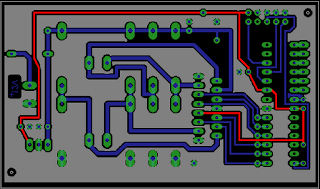It constantly measures the car battery
voltage and based on the voltage level it knows if the engine is running or
not. When engine is running it switches DRL lights on. Depending on the selected operation mode it simply switches DRLs on and off or it dims
up and down. It also monitors state of low-beam
light and turn indicator to perform some other nice things.
When engine is switched on (car battery
voltage is above 13.5V):
-switches DRL off when it detects that
low-beam lights are on
-switched DRL on when it detectd that
low-beam lights are off so car battery will last for a longer
time if you left it for a while.
When engine is switched off (car
battery voltage is below 13.0V):
-switches DRL on for a 30 seconds when
it detects that car have been just locked or unlocked. It simply
detects one or couple of blinks which are usually emitted when you
lock or unlock your car with remote controller. This function is
something like “follow me home” lights, DRLs consume so little
power that it's not a problem to switch them on for such a short
time.
-when DRLs are already on and circuit
will detect that car has been again locked or unlocked it will switch
DRLs off. So you can use your remote to switch DRLs on and off when
your car is parked
-detects emergency lights being switched
on – in such case it will ignore blinking turn signals and will
keep DRL lights off.
Car battery monitoring serves as
protection against deep discharge in case of alternator failure. It
also switches DRLs on after the engine has started. It doesn't consume
power at that exact moment when engine starter works so it eases start-up.
Whole circuit in stand-by consumes less
than 1.5mA, it would take about 2 years to discharge a typical car
battery with this current. It is protected against
wrong polarity and thanks to fuse it is protected against DRL short
circuit. It can control DRLs up to 30Wats, witch in case of LED DRLs
is far enough.
Why did I build it?
My car wasn't factory fitted with day
running lights. In my country it is legal obligation to always drive
with day running lights or with low-beam lights on. I once calculated
that low-beam lights which consume more that 110Wats increase fuel
consumption by around 0.25 l/100km (approximately 1,5 mpg US). I can
prove it using a pencil and a sheet of paper. LED DRL consumes about 10Wats.
According to EU law DRL lights should be automatically switched on
when engine is started and they also should by switched off when
low-beam lights are switched on. This automation is usually done by a
simple relay connected to low-beam light and a wire which is
connected to +12V simultaneously with turning on ignition. Using
relay, although it's simple, has got disadvantages. Typical
relay-based controller unnecessary drains car battery when engine is
starting, it also needs to be connected to wire which is connected to
battery positive terminal simultaneously with ignition. In my car it
is not so easy access such a wire. I noticed that cars battery is quite
easy accessible and project has started. I draw a simple circuit mentioned in
one of my previous posts, I designed PCB keeping in mind that it have
to fit to a typical plastic housing and ordered handful of necessary
components.
After two weeks of impatient waiting I finally received 12 brand new PCBs for my Day Runnig Light controller. They fit to plastic housing which I had bought earlier. Looks like they will be ready for testing in a next week.
I have mounted 4 pieces so far –
that's enough for development purposes:
PCBs are sealed with epoxy to make sure
that they will survive dust, moisture and wide range of temperatures.
On the picture below I marked pin order.
How to connect it?
Connections which you have to make are
marked with colors, connections which are already in your car are
marked with black.
Sometimes there are issues with
particular DRL lights which don't like dimming, this controller can
work in two modes: with or without dimming. When it works without
dimming it does exactly the same thing but it adds some extra delays
instead of dimm-up and dimm-down periods. There is no switch to
choose whether it does dimming or not. Instead of some potentially
unreliable switch it uses tricky technique: it learns which input is
connected to low-beam light.
If low-beam light is on INPUT1 (and
consequently turn indicator on INPUT2) DRLv2 works with dimming. If
you swap it and connect low-beam light to INPUT2 it will work without
dimming.
Controller learns on which input there
are short pulses (turn indicator) and on which there is constant
positive state (low-beam). After installing controller into your
car you should switch low-beam lights for let's say 5 seconds or
longer so it can learn that this is low-beam input and choose desired
mode.


















